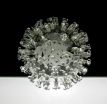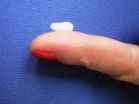(Press-News.org) Under the electron microscope, a coronavirus may resemble a spiny sea urchin or appear crownlike, (the shape from which this family of pathogens takes its name). Previously recognized as the second leading cause of the common cold in humans and for economically important diseases in many domesticated animals, a new disease form abruptly emerged as a major public health concern in 2002, when the SARS coronavirus (CoV) surfaced in Asia.
The rapid spread of the virus caused significant social and economic disruption worldwide , infecting over 8000 people with Sudden Acute Respiratory Syndrome or SARS and killing about 10 percent of them. While SARS-CoV was brought under control through decisive action by health officials, the sudden scourge underlined the threat posed by coronaviruses and spurred new research into the inner workings of these infectious agents.
Brenda Hogue and her colleagues at the Biodesign Institute at Arizona State University are studying the intricate formation of these viruses—a process known as viral assembly. The research may offer fresh insight, leading to a new generation of antiviral agents that can disrupt the ability of coronaviruses like SARS to assemble viable infectious particles. Such strategies may prove applicable against other classes of virus as well.
The group's work recently appeared in the Journal of Virology.
Viruses, Hogue stresses, differ fundamentally from other common microscopic pathogens like bacteria, in that viruses are structurally primitive, lacking the means to independently replicate. Viruses are composed of genetic information (DNA or RNA), encased by proteins. They exist in a shadowy region between living and non-living entities.
In order for a virus to replicate, it must commandeer machinery of a host cell it has infected. Nevertheless, viruses have evolved to be highly adept at this sort of replication-by-proxy, and can infect virtually all types of organisms, from animals and plants to bacteria and even Archaea. Viruses—of which millions of forms are known to exist—are far and away the most numerous (and successful) parasitic invaders on earth.
"Coronaviruses are a very large family of RNA viruses," Hogue says. "They infect humans and a broad range of animals." While the symptoms produced by coronavirus infection in humans tend to be respiratory, in animals, such viruses can cause a range of severe problems, from neurological ailments to immunosuppressive effects. Various coronaviruses are responsible for common colds in humans, though the combined upper and lower respiratory symptoms and gastrointestinal complications seen in SARS patients are unusual.
In the study reported in Journal of Virology, Hogue and her team closely examined one of the major proteins found in the coronavirus that is crucial to the pathogen's process of assembly. Known as the M, it is one of four proteins, in addition to S, N and E, required to produce a fully assembled viral particle, capable of infecting a host.
The membrane (M) protein makes up the bulk of the outer shell or envelope of the virus, forming a lattice that surrounds and shields the viral genome. The spike protein (S)—named for its spike-like or crown-like appearance under electron microscopy, is critical for allowing the coronavirus to attach to the host cell's receptors, prior to viral entry into the cell. The nucleocapsid (N) protein encapsidates the genomic RNA. The envelope or E protein is the least plentiful protein known to play a central role in virus assembly, though its presence is very important. In addition to assisting viral assembly, the E protein also appears to be involved in shuttling the newly assembled virions out of the cell, enabling these particles to escape and infect other host cells in the exponential process of viral infection.
The group wanted to determine the requirements for the M protein to function during assembly of the viral envelope. To establish this, coronaviruses were genetically manipulated to form mutant versions, exhibiting varying degrees of viability. Much of this manipulation focused on domains within the viral genome coding for a distinct structural and/or functional domain of the M protein. Conserved domains, as they are known, contain genetic sequence patterns or motifs that tend to recur across a number of different viruses or within a particular virus type, like catch phrases recurring in different books. These conserved domains are generally involved in functions essential to viral formation, survival or replication, making them an attractive target for therapeutic efforts designed to short-circuit viral assembly.
Viral pathogens like the SARS coronavirus, (along with hepatitis C and influenza), use RNA rather than DNA as their genetic material. In general, such RNA viruses mutate more rapidly than DNA viruses, posing particular challenges to virologists hoping to combat them. They can also acquire alterations that allow them to hop from one species to another. Something like this now appears to be at the root of the SARS outbreak.
"We think that the reservoir for this virus is bats, because a large number of SARS-like viruses have been isolated from bat populations around the world," Hogue says. SARS-CoV was subsequently able to infect a secondary animal host, now believed to be the civet cat—a mongoose-like creature found in Asia and sometimes used as a food source, particularly in China, where the SARS outbreak originated. Contact with infected civets in the open markets may have caused the initial human cases of SARS, which then rapidly spread— human to human—from the Guangdong provinces in China to 37 countries.
Viruses that act as respiratory pathogens, including SARS, are highly transmissible from person to person through contact with respiratory droplets that become aerosolized from coughs or sneezes. Virions may also persist on surfaces that come in contact with an infected individual. Following transmission, virions initiate the infectious process of host cells, which transpires in several important phases.
First, viral proteins located on the virus' outer capsid bind to particular receptors on the host cell's surface. Next, virions enter the cell, either by fusing their membranes with those of the host cell or through the process of endocytosis, in which the host cell takes in the virion in a membrane-bound vesicle. The virion is now in a position to begin the replication cycle, releasing its genetic material into the cell. The viral genome encodes genes that when expressed, yield the protein components necessary to assemble new virus particles.
Hogue stresses the importance of in silico analysis, in which large libraries of proteins can be screened through analysis, in order to identify conserved and non-conserved protein regions, thus greatly accelerating the pace of discovery. "The more we learn about these particular regions of proteins that are critically important for the assembly process," she says, "the likelier it is we can design molecules that will be able to interfere with this process."
While some conserved domain alterations in the M protein proved lethal to coronaviruses, others undermined viral assembly without shutting it down completely, often causing compensatory efforts on the part of the virus, (known as second site changes) which may offer insights into the virus' adaptive capabilities. In the coming year, Hogue plans to examine the non-lethal changes introduced, studying these mutant viruses under high-resolution cryo-EM, to determine how alterations of specific domains affect overall coronaviral structure.
Additionally, Hogue's group is closely examining the under-represented envelope or E protein. "One reason we are excited about this is that a number of enveloped viruses, including hepatitis C, influenza and others, that are of real medical significance, have small ion channel proteins," Hogue says. "If we can develop ways to target and obliterate the ion channel activities of these proteins, we may be able to disable these viruses and prevent or reduce infections."
INFORMATION:
Brenda Hogue is a researcher in the Center for Infectious Diseases and Vaccinology at the Biodesign Institute and is also Associate Professor in the College of Liberal Arts and Sciences, School of Life Sciences at Arizona State University.
Written by: Richard Harth
Science Writer: The Biodesign Institute
richard.harth@asu.edu
New research aims to shut down viral assembly line
2011-01-12
ELSE PRESS RELEASES FROM THIS DATE:
New MS target identified by Canadian researchers
2011-01-12
Multiple sclerosis (MS) is a disease caused by damage to myelin – the protective covering wrapped around the nerves of the central nervous system (CNS).
Previous studies have shown that certain white blood (immune) cells, called leukocytes, infiltrate the CNS and play a significant role in causing the damage that contributes to MS symptoms. It has also been shown that these leukocytes enter the CNS with help from a family of molecules called MMPs.
Using a mouse model, researchers have discovered that a molecular switch called EMMPRIN plays an important role in MS. The ...
Cell Transplantation reports a success in treating end-stage liver disease
2011-01-12
Tampa, Fla. (Jan. 10, 2011) – Transplanting their own (autologous) bone marrow-derived stem cells into 48 patients with end-stage liver disease resulted in therapeutic benefit to a high number of the patients, report researchers publishing in the current issue of Cell Transplantation (19:11). Yet, the mechanism by which the infusion of CD34+ stem cells improves liver function remains elusive, they say.
The study, carried out by a team of researchers in California and in Egypt, is now freely available on-line at http://www.ingentaconnect.com/content/cog/ct/.
According ...
International first: Gas-phase carbonic acid isolated
2011-01-12
A team of chemists headed by Thomas Loerting from the University of Innsbruck and Hinrich Grothe from the Vienna University of Technology (TU Wien) in Austria have prepared and isolated gas-phase carbonic acid and have succeeded in characterizing the gas-phase molecules by using infrared spectroscopy. The results were published in the journal Angewandte Chemie International Edition.
In textbooks and other media the widespread belief still prevails that stable carbonic acid cannot be produced in pure form and is practically non-existent as it immediately decomposes to ...
'Taking children seriously'
2011-01-12
Small children are capable of engaging in issues concerning sustainable development.Their interests and rights must be better safeguarded in rules and policy decisions that concern the education of the youngest groups of children within the EU.
This is emphasised in the report "Taking children seriously – How the EU can invest in early childhood education for a sustainable future", which was presented at a seminar in Brussels on Friday 17 December.
The body behind the report is the European Panel on Sustainable Development (EPSD), an independent research-based network ...
Wildlife biologists use dogs' scat-sniffing talents for good
2011-01-12
Berkeley — It will come as no surprise to dog owners that their four-legged friends have a flair for sniffing out the excrement of other animals. Now, biologists at the University of California, Berkeley, have trained dogs to detect the scat of other critters for the greater good – to conduct more accurate surveys of wildlife.
"Wildlife detection dogs have been mostly used in airports to detect contraband, including endangered species and wildlife products, but in recent years, interest has grown in using the dogs to help scientists track biological targets in natural ...
Nanodisk gene therapy
2011-01-12
One of the challenges of gene therapy - a set of methodologies aimed at treating several nucleic acid diseases (DNA or RNA) - is to assure that this material arrives directly to the nucleus of the cell without losing a substantial amount along the way and without producing any undesired side effects. With this aim, scientists experiment with the use of different types of vectors, molecules capable of transporting genetic material to the correct place. Presently, natural "deactivated" viruses are the most commonly used vectors in clinical trials, their side effects however ...
New markers for allergic disorders thanks to analysis of medical databases
2011-01-12
Researchers at the University of Gothenburg, Sweden, have developed new methods for analysing medical databases that can be used to identify diagnostic markers more quickly and to personalise medication for allergic disorders. They could also reduce the need for animal trials in clinical studies.
Published in the journal PLoS Computational Biology, the study builds on data analyses of freely available medical databases representing studies of countless numbers of patients in the
PubMed database, and microarray data in another major database. The use of microarrays is ...
Winter sports threaten indigenous mountain birds
2011-01-12
In the winter months, the mountain ranges of central Europe attract thousands of tourists for skiing, snowboarding and other outdoor sports, but conservationists fear this annual invasion may threaten indigenous bird species, including the Capercaillie. The research, published in the journal IBIS, reveals how the growth of human recreation may be a key factor in the rapidly declining population of these iconic alpine birds.
The Capercaillie (Tetrao urogallus), also known as the Wood Grouse, is the largest member of the grouse family and is renowned for its mating display. ...
Consumption Report 2010: Swedes' alcohol consumption is falling
2011-01-12
Swedes drink less and less alcohol while at the same time the Swedish Alcohol Retail Monopoly's sales
are rising and statistics from Statistics Sweden show that alcohol consumption is on the increase. This
has been the trend for a long period of time. Statistics from the Centre for Social Research on Alcohol
and Drugs, SoRAD, show that alcohol consumption fell continuously in the period from 2004 to 2009,
whereas the Swedish Alcohol Retail Monopoly's sales rose by 22% over the same period. The Swedish
Alcohol Retail Monopoly's sales rose by 10% from 2008 to 2009, whereas ...
Scientists explain link between chlamydia and ectopic pregnancy
2011-01-12
Women who have had chlamydia are at greater risk of an ectopic pregnancy because of a lasting effect of the infection.
A new study provides evidence for the first time of how chlamydia can increase the risk of an ectopic pregnancy – which occurs when an embryo implants outside the womb, in the Fallopian tube.
Researchers at the University of Edinburgh found that women who had had the sexually transmitted infection were more likely to produce a particular protein in their Fallopian tubes.
Increased production of this protein – known as PROKR2 – makes a pregnancy more ...



